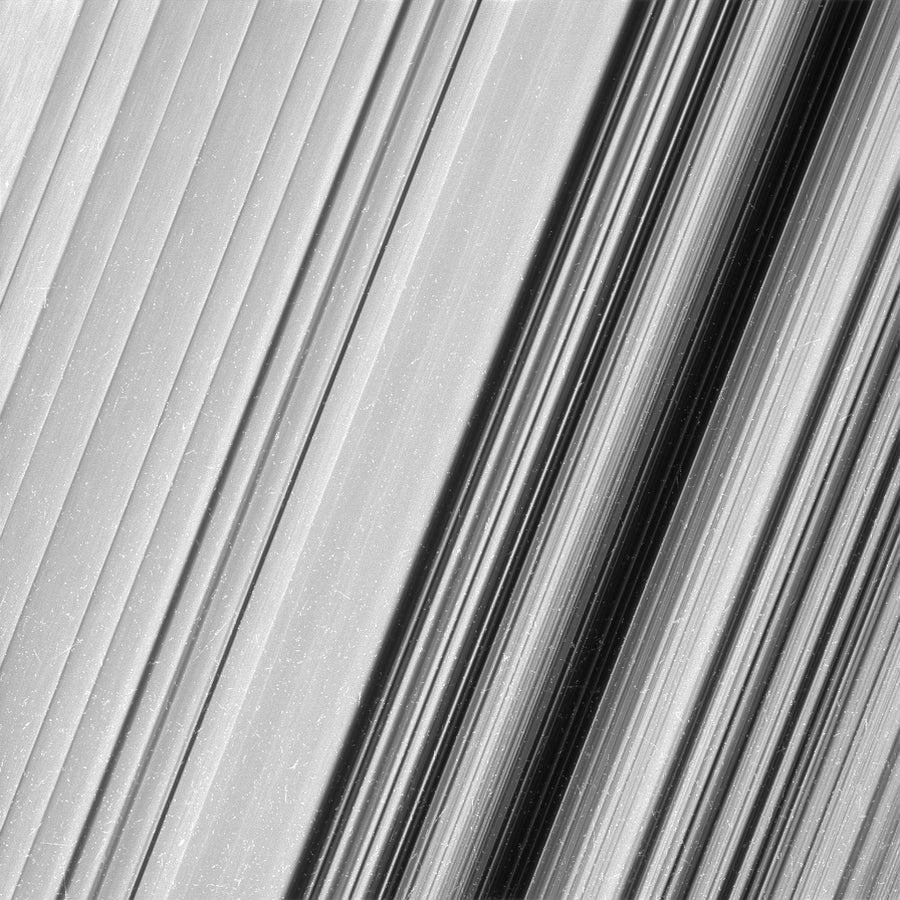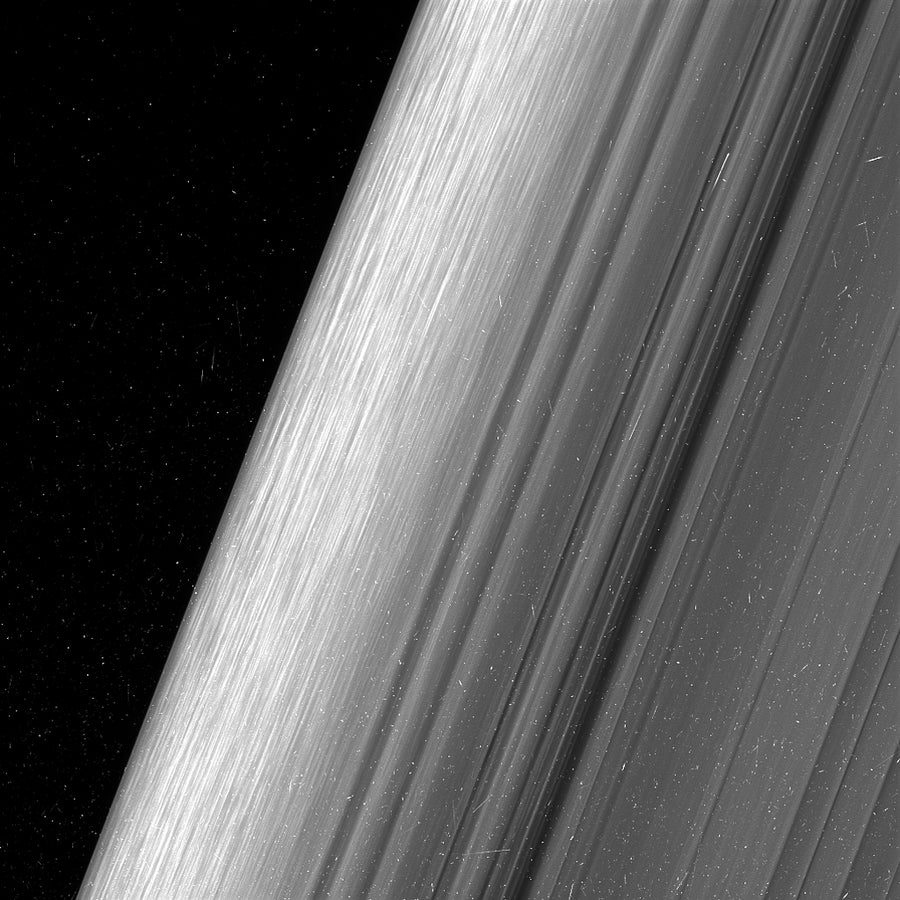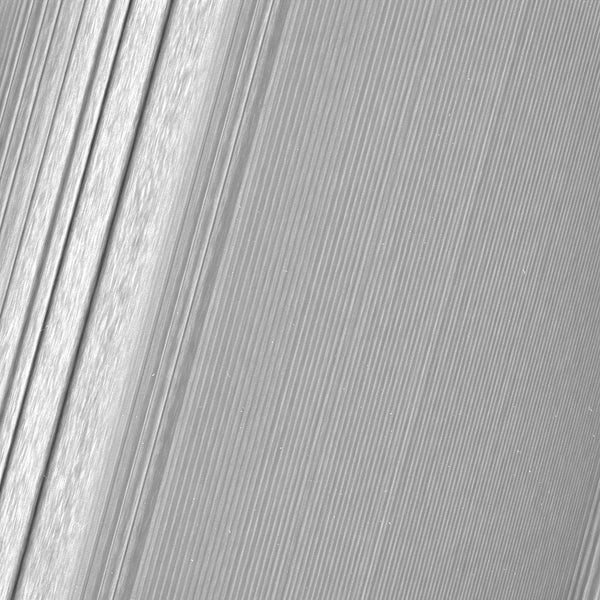Spectacular new close-up images of Saturn’s rings from the Cassini spacecraft reveal phenomena that reinforce scientists’ theories about how planets and moons form and interact—but also some patterns and structures they can’t yet explain.
One of the most interesting features visible in the images is a swarm of so-called propellers, or disturbances caused by moonlets embedded in Saturn’s A ring—the outermost of the planet’s large, bright rings. In the images the propellers appear as faint white streaks running with the apparent grain of the ring. Most of the particles comprising the rings range from marble-size to house-size—but these moonlets, also known as propeller moons, are as big as a football field, according to Matthew Tiscareno, a rings expert on the Cassini team at the SETI Institute. “We’ve not been able to observe the football-field-sized moon but what we can do is observe the disturbance, and track it and learn about it,” Tiscareno says. This up-close look at the movement of embedded moonlets is new to researchers and could help them understand how the disturbances affect the rings, which could in turn allow them to piece together a more complete picture of how fledgling planets form from smaller building blocks within protoplanetary disks around newborn stars.
The propeller images were taken from the dark side of the rings. Next month Cassini is scheduled to obtain images from the sunlit side, where scientists hope the moonlets will appear in sharper detail. Cassini had an even closer glimpse of the rings once before, 13 years ago, as the craft first entered Saturn’s orbit and skimmed laterally across the rings’ surface. But those images were taken at extremely short exposures to reduce motion blur, and came out dark and noisy.
On supporting science journalism
If you're enjoying this article, consider supporting our award-winning journalism by subscribing. By purchasing a subscription you are helping to ensure the future of impactful stories about the discoveries and ideas shaping our world today.

This image shows a region in Saturn's outer B ring. NASA's Cassini spacecraft viewed this area at a level of detail twice as high as it had ever been observed before. Credit: NASA, JPL-Caltech, Space Science Institute
One factor that makes the latest images superior is that Cassini has been in polar orbit since September, rather than circling the planet’s equator parallel to the rings. As the spacecraft plunges from one pole toward the other, the rings appear relatively more stationary in its field of view for longer periods of time. This lets researchers choreograph more deliberate, long-exposure shots to enhance brightness. “The other thing is that when we were just getting to Saturn in 2004 we had not spent 13 years studying the rings close up, so we didn’t really know where to look for the most interesting views,” Tiscareno adds.
Another image captured a high-resolution view of a variegated feature called a spiral density wave within the rings, produced by motions of Saturn’s small moon, Janus. Spiral density waves are compression patterns, or pileups of mass, which can appear as the spiral arms of disk galaxies, and could offer insights into how galaxies are formed and maintained. “This spiral density wave sets itself up at the place where ring particles are going around Saturn exactly six times every time the moon Janus goes around five times,” Tiscareno says. As the orbiting moon and the ring particles regularly nudge each other gravitationally, they form rippling waves in the rings. The waves appear as dark, narrow bands where ring particles have been compressed, and wider, lighter-color bands where the particles have spread back out. The structure of the lighter bands is often referred to as “straw” due to its stringy, fibrous appearance, which researchers have not yet fully explained.
A different section of the same image shows “moon wakes,” features that resemble grooves on a vinyl record, where the moon Pan has passed without the precise resonance that Janus exacts on the other section of the ring. “Instead of frequencies needing to match up, every time a moon goes by it stirs up everything,” Tiscareno says.

This image shows a region in Saturn's outer B ring. Credit: NASA, JPL-Caltech, Space Science Institute
The new set of images also includes a view of Saturn’s superdense B ring—the highest-resolution image ever taken of this ring by a factor of at least 2. The great variety in widths and textures of the bands cannot be accounted for yet. “Why is it organizing itself in this way? We are trying to figure that out,” Tiscareno says. “There are some theories about some kind of vibrations that can set themselves up in a system like this, but those should all have the same wavelength, which clearly this doesn’t.” It’s something they’ll need to study more.
Cassini is now in the first of two phases of its polar orbit. The next will be the mission’s grand finale, when the craft will pass between the planet and its rings, instead of outside them, en route to a fiery final mission-ending plunge into the giant planet’s atmosphere. This will offer one last new view of the rings, plus the chance to measure the gravitational pull of the rings themselves, which it has so far been impossible to do from the outside.
